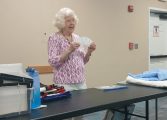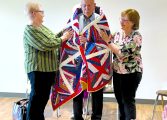For seven years he was the director of training and chief learning officer for the U.S. Department of Commerce in Washington, D.C., before retiring from the federal government. He also founded and chaired the federal interagency Chief Learning Officers Council. The council was composed of the highest-ranking chief learning officers in the federal government. Lang continues to consult for various federal agencies in Washington, D.C.
With all that behind him, one would expect a professorial type who glances over the rim of his glasses with serious pomp and circumstance, surrounded by piles of university journals and dry and dusty books. Lang is not someone who talks above everyone’s head from an erudite ivory tower, but is relaxed, charming, and grounded in his thoughts.
“My passion has always been about leadership development and the mark it can leave on our institutions and organizations,” he said.
After four and a half years of research and writing, he just completed Leadership Lessons from Great World Leaders. A timely book with a provocative title, it profiles 10 well-known leaders from world history. Lang’s motivation for writing this book comes from his passion on the subject of leadership, and his own management background, positions, and experience teaching others to lead.
“I rated their leadership skills, providing insight and lessons for reflection as to how they applied leadership in their lives and their places in history,” Lang said. Although the book is not yet available, the manuscript is now being used by Bellevue University in its doctoral program. “I always felt that the teaching of leadership theory in colleges and universities should be reinforced by instruction about how real people in history applied these theories in practice. I wanted to write this book for 20 years,” he said.
Lang picked the following to profile: Alexander the Great, Elizabeth I, Peter the Great, George Washington, Winston Churchill, Golda Meir, Napoleon Bonaparte, Catherine the Great, Martin Luther King, Jr., and Margaret Thatcher. He selected leaders from multiple countries for international appeal as well as diverse categories, including kings and queens, the military, presidents and statesmen, and reformer-activists.
“I selected leaders from ancient and contemporary history that represent many countries and both genders. I have always felt that the female gender is underrepresented in leadership discussions and I wanted to be more inclusive in this work,” Lang said.
“While conducting research for this book, I never discovered a consensus on the attributes of a good leader,” Lang continued. “After examining the number of times an attribute appeared, I discovered six major themes of great leaders. They are: integrity, risk taker, communication, passion, vision, and resiliency.”
Lang tried to measure those leaders against the six major themes he discovered. “No one leader that I researched maximized all six leadership characteristics,” he said. “In my opinion, any leader who aspires to great societal goals that improve the lives of all followers is considered a great leader.”
The difference between good leaders and great leaders is “the passion and intensity those leaders convey to their followers about their commitment to significant issues” and the extent to which those followers are therefore mobilized, Lang said.“Martin Luther King, Jr., summed it up nicely when he said: ‘Ultimately a genuine leader is not a searcher for consensus but a molder of consensus,’” Lang said.
Lang’s purpose in writing his book was not to replace traditional leadership training, but to “complement it with how leadership is actually being applied by great leaders who made their mark in history,” he said. “Readers of this book will learn how an unremarkable student, Winston Churchill, became a great leader. They will learn how a student was bullied in school and rose to become one of the greatest leaders in history – that was Napoleon Bonaparte. Or how a poor American-Russian girl – Golda Meir – through her passion, became the first female prime minister of a European country.”
Published by American Press Publishers, the book will be available for colleges and universities, training associations, leadership institutes, and traditional retail outlets. Lang also said it was a great opportunity to partner with his talented artist wife, Susan, who did the illustrations for the book. He said he is excited about its imminent release.




